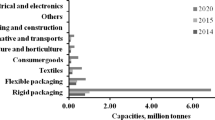Abstract
With the increasing concern about the depletion of fossil reserves and greenhouse gas emissions, it is desired to replace coatings which are made using petrochemical-based materials with renewable alternatives such as bio-based polymers. In this paper, fully bio-based thermosets for coatings were prepared from epoxidized sucrose soyate derived from sucrose and soybean oil fatty acid along with citric and malic acids found naturally in juices with the assistance of different solvents. The solvents with reasonable boiling point and good miscibility with citric acid and malic acid, such as water, ethanol, 1-propanol, 2-propanol, and 1,4-dioxane, were screened and used to investigate their effects on the curing and properties of the fully bio-based thermosets. The curing reactivity was studied by examining the gel time and nonisothermal curing process with DSC. The thermal and mechanical properties as well as coating performance properties were also investigated.







Similar content being viewed by others
References
Ma, SQ, Liu, X, Jiang, Y, Tang, Z, Zhang, C, Zhu, J, “Bio-based Epoxy Resin from Itaconic Acid and Its Thermosets Cured with Anhydride and Comonomers.” Green Chem., 15 (1) 245–254 (2013)
Auvergne, R, Caillol, S, David, G, Boutevin, B, Pascault, JP, “Biobased Thermosetting Epoxy: Present and Future.” Chem. Rev., 114 (2) 1082–1115 (2014)
Shen, L, Haufe, J, Patel, MK, Product Overview and Market Projection of Emerging Bio-based Plastics PRO-BIP 2009. Report for European Polysaccharide Network of Excellence (EPNOE) and European Bioplastics, 243 (2009)
Chen, GQ, Patel, MK, “Plastics Derived from Biological Sources: Present and Future: A Technical and Environmental Review.” Chem. Rev., 112 (4) 2082–2099 (2012)
Halden, RU, “Plastics and health risks.” Ann. Rev. Public Health, 31 179–194 (2010)
Delidovich, I, Hausoul, PJC, Deng, L, Pfützenreuter, R, Rose, M, Palkovits, R, “Alternative Monomers Based on Lignocellulose and Their Use for Polymer Production.” Chem. Rev., 116 (3) 1540–1599 (2016)
Ma, S, Li, T, Liu, X, Zhu, J, “Research Progress on Bio-based Thermosetting Resins.” Polym. Int., 65 (2) 164–173 (2016)
Ma, S, Webster, DC, Jabeen, F, “Hard and Flexible, Degradable Thermosets from Renewable Bioresources with the Assistance of Water and Ethanol.” Macromolecules, 49 (10) 3780–3788 (2016)
Dai, J, Ma, S, Liu, X, Han, L, Wu, Y, Dai, X, Zhu, J, “Synthesis of Bio-based Unsaturated Polyester Resins and Their Application in Waterborne UV-Curable Coatings.” Prog. Org. Coat., 78 49–54 (2015)
Dai, J, Ma, S, Wu, Y, Zhu, J, Liu, X, “High Bio-Based Content Waterborne UV-Curable Coatings with Excellent Adhesion and Flexibility.” Prog. Org. Coat., 87 197–203 (2015)
Pan, X, Sengupta, P, Webster, DC, “Novel Biobased Epoxy Compounds: Epoxidized Sucrose Esters of Fatty Acids.” Green Chem., 13 (4) 965–975 (2011)
Pan, X, Webster, DC, “Impact of Structure and Functionality of Core Polyol in Highly Functional Biobased Epoxy Resins.” Macromol. Rapid Commun., 32 (17) 1324–1330 (2011)
Monono, EM, Bahr, JA, Pryor, SW, Webster, DC, Wiesenborn, DP, “Optimizing Process Parameters of Epoxidized Sucrose Soyate Synthesis for Industrial Scale Production.” Org. Process Res. Dev., 19 (11) 1683–1692 (2015)
Pan, X, Sengupta, P, Webster, DC, “High Biobased Content Epoxy-Anhydride Thermosets from Epoxidized Sucrose Esters of Fatty Acids.” Biomacromolecules, 12 (6) 2416–2428 (2011)
Kovash, CS, Pavlacky, E, Selvakumar, S, Sibi, MP, Webster, DC, “Thermoset Coatings from Epoxidized Sucrose Soyate and Blocked, Bio-Based Dicarboxylic Acids.” ChemSusChem, 7 (8) 2289–2294 (2014)
Ma, S, Webster, DC, “Naturally Occurring Acids as Cross-Linkers To Yield VOC-Free, High-Performance, Fully Bio-Based, Degradable Thermosets.” Macromolecules, 48 (19) 7127–7137 (2015)
Penniston, KL, Nakada, SY, Holmes, RP, Assimos, DG, “Quantitative Assessment of Citric Acid in Lemon Juice, Lime Juice, and Commercially-Available Fruit Juice Products.” J. Endourol., 22 (3) 567–570 (2008)
Eisele, TA, Drake, SR, “The Partial Compositional Characteristics of Apple Juice from 175 Apple Varieties.” J. Food Compos. Anal., 18 (2–3) 213–221 (2005)
Monono, EM, Bahr, JA, Pryor, SW, Webster, DC, Wiesenborn, DC, “Optimizing Process Parameters of Epoxidized Sucrose Soyate Synthesis for Industrial Scale Production.” Org. Process Res. Dev., 19 (11) 1683–1692 (2015)
Ma, S, Liu, X, Fan, L, Jiang, Y, Cao, L, Tang, Z, Zhu, J, “Synthesis and Properties of a Bio-Based Epoxy Resin with High Epoxy Value and Low Viscosity.” ChemSusChem, 7 (2) 555–562 (2014)
Scanlan, J, “The Effect of Network Flaws on the Elastic Properties of Vulcanizates.” J. Polym. Sci., 43 (142) 501–508 (1960)
Hill, LW, “Calculation of Cross-Link Density in Short Chain Networks.” Prog. Org. Coat., 31 (3) 235–243 (1997)
Aouf, C, Nouailhas, H, Fache, M, Caillol, S, Boutevin, B, Fulcrand, H, “Multi-functionalization of Gallic Acid. Synthesis of a Novel Bio-based Epoxy Resin.” Eur. Polym. J., 49 (6) 1185–1195 (2013)
Chiu, YC, Chou, IC, Tseng, WC, Ma, CCM, “Preparation and Thermal Properties of Diglycidylether Sulfone Epoxy.” Polym. Degrad. Stab., 93 (3) 668–676 (2008)
Acknowledgments
This work was supported by the National Science Foundation under Grant No. NSF EPSCoR Award IIA-1355466.
Author information
Authors and Affiliations
Corresponding author
Additional information
This paper was presented at the American Coatings Conference, April 11–13, 2016 in Indianapolis, IN.
Rights and permissions
About this article
Cite this article
Ma, S., Kovash, C.S. & Webster, D.C. Effect of solvents on the curing and properties of fully bio-based thermosets for coatings. J Coat Technol Res 14, 367–375 (2017). https://doi.org/10.1007/s11998-016-9863-8
Published:
Issue Date:
DOI: https://doi.org/10.1007/s11998-016-9863-8




